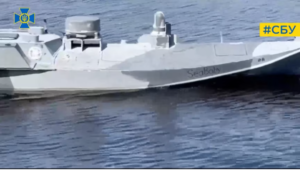On the evening of Friday, September 16, 2022, Elon Musk was stressed.
His phone had been blowing up with panicked texts from Ukraine.
Elon Musk — the rocket guy, electric car guy, Twitter guy — was being asked to make a decision that he thought would change the fate of the war in Ukraine.
You see, at that exact moment, a tiny fleet of Ukrainian remote-controlled boats were skipping over the waves of the Black Sea to blow up a Russian fleet.
They were about the size of every boat owned by a suburban dad who parks it outside the house but rarely uses it.
They were black, they had quiet electric engines, and they had explosives inside.
Their target was the ominously titled Russian Black Sea Fleet, which patrols and protects Crimea — a region the Russians took from Ukraine back in 2014.
In a surprise attack, in the dead of night, the Ukrainians were going to take the Russian fleet out.
So what does this have to do with Elon Musk?

The boats were operated using satellite internet, provided by Musk’s SpaceX.
Ukraine calls this type of boat a “SeaBaby”.
But they’d hit an unexpected snag. As the SeaBabies sped towards their target, they reached an invisible fence, 100km off the Crimean coast.
The satellites work in Ukraine, where they were coming from. They don’t work in Russian-controlled Crimea. There, they are disabled.
But the Ukrainians didn’t realise this until their boats crossed the invisible line and went dark.
The Ukrainian deputy prime minister fired off texts directly to Elon Musk, begging him to turn on the satellites and reconnect their boats.
Musk jumped on Twitter, and posted “Starlink is meant for peaceful use only”.
A few days later, a bunch of SeaBabies were found washed up on the Crimean coast. Any chance of a surprise attack was gone.
How did we get into a situation where Elon Musk gets to personally decide whether a Ukrainian military operation succeeds or fails.
And was he justified in refusing to help Ukraine attack Russia?
What is Starlink?
The internet can be hard to access in a war zone, which is why you might turn to satellite internet.
Satellite internet isn’t new but Elon Musk’s company came up with a revolutionary way to use it.
In May 2019, SpaceX started launching batches of satellites into orbit.
Each one was 260kg — very small for a satellite — and would orbit at around 500km above the Earth’s surface.
There’s now 5,000 Starlink satellites in orbit and they provide faster and cheaper internet than previous generations of satellite internet.
It’s designed to bring internet access to people who need it, people like Ukrainians, suddenly cut off from the world as their country turned into a war zone.
How did Starlink end up in Ukraine?
At the beginning of the 2022 invasion, Ukraine had three types of internet access — landline, mobile, and a geostationary satellite supplied by American company ViaSat.
The first Russian cyberattack took out the satellite network before the first shot of the war was fired.
It meant Ukrainian military systems were cooked, but surprisingly mobile phones were still working.
Why would Russia take out the satellite but leave the mobile network virtually untouched?
Especially given that it seemed to give the Ukrainian defence an unexpected advantage — citizens were able to report Russian troop movements directly to the defence department via a government enabled app.
So, why was the internet still working? Well, the Russians needed it.
Thanks to classic Soviet-style corruption, a years-long multi-billion-dollar effort to get new secure long-range radios for the military had delivered nothing but fat pockets for suppliers and middle managers.
Russian officers had to resort to sticking Ukrainian SIM cards in their own phones and using them to coordinate attacks.
A Russian general even admitted that phone signals of Russian soldiers allowed Ukrainian forces to target them with artillery, and kill them.
Eventually, after the initial attempt to capture the Ukrainian capital Kyiv failed, Russian troops withdrew to the south-east of the country.
Finally they started bombing, hacking and jamming the Ukrainian mobile internet.
So with both satellite and mobile internet down, Elon Musk was asked by the Ukrainian government to help, and he swung in on a vine to rescue them.
Starlink provides internet across Ukraine
Elon Musk likes being a hero and doesn’t really love being challenged on that.
I’m sure you can remember the time he delivered a child-sized submarine to the cave system in Thailand that professional divers could barely wriggle their way through.
Then when challenged by one of the divers on CNN, he called the diver a “pedo guy”.
But Ukraine seemed like a situation where he genuinely was the hero. Starlink was used to set up the internet in towns across the country.
It provided wi-fi on Ukrainian intercity trains — something we don’t have in Australia, it’s worth noting.
And, despite a clause in the Starlink terms of service stating “Starlink is not designed or intended for use with or in offensive or defensive weaponry or other comparable end-uses” it was used extensively by the Ukrainian military.
I mean, who reads those terms of service things anyway?
Musk freely admitted it, saying “Starlink today is the backbone of the Ukrainian military. It is still the only one that’s effective at the front lines.”
Ukraine’s military uses it for directing drones, to help with aiming artillery strikes, and for encrypted communications between soldiers and commanders.
As Ukrainian forces push forwards and liberate Russian-held towns, they bring Starlink terminals with them.
This is an extremely unusual situation — a private American company playing a direct and pivotal role in a European War.
While other military contractors are contributing to Ukraine’s war effort, it’s via the US government — they sell stuff to middle-man Joe Biden, who gives it to Ukraine.
But Musk is in total control of his satellites.
Which puts him in a delicate position when Ukraine needed his satellites to cry “havoc” and let slip the SeaBabies of war.
Musk’s decision changes course of the war
Elon Musk is not a defence or foreign policy expert, but he is a bit of a history buff.
He knows that the Japanese attack on the US fleet in Pearl Harbor in 1941 brought the United States into World War II and ultimately ended badly for Japan.
This was what was in his head when he started getting texts from Ukraine asking him to turn Starlink on to help the SeaBabies attack the Ukrainian fleet.
Why was Pearl Harbour in his head?
Well, according to a biography just released by Walter Isaacson, the Russian ambassador to the US had told him weeks earlier that if Ukraine attacked the Russians at that port, the conflict would escalate into a nuclear war.
That helped him decide.
Musk told his biographer that he didn’t want to be part of the next Pearl Harbor, so he made the decision not to turn on the satellites.
It wasn’t the only time. When Ukraine has taken back territory from Russia, they’ve struggled to get Starlink to follow them.
Now on one hand, Elon Musk is a private business owner and he can do whatever he likes with his cloud of satellites, but that doesn’t mean Ukrainians are happy about it.
Elon Musk wasn’t actively working on the side of Russia, but he was buying into their propaganda.
If the SeaBabies had reached their targets, it wouldn’t have led to World War III.
We know that because Ukraine’s hit the Black Sea Fleet several times since, and World War III hasn’t started.
Russia was bluffing, and Musk bought it.
After another chat with the Russian ambassador, Musk pitched a peace plan that was also full of Russian propaganda.
He popped a poll up on Twitter asking people to vote on his peace plan which included Ukraine just giving up on retaking Crimea because, in his view, it was part of Russia anyway.
Ukrainian President Volodymyr Zelenskyy responded with his own poll: “Which Elon Musk do you like more? One who supports Ukraine, or one who supports Russia?”
Ukraine’s ambassador to Germany told Musk to “f*** off”.
Not only that, but a lot of negative press started coming out about his interactions with the Ukrainian defence force.
He was clearly unsettled by the experience. In the following weeks he started complaining about having to stay involved in the war.
CNN reported that Musk claimed SpaceX was running out of money to run Starlink in Ukraine.
To date, he hasn’t cut Ukraine off, but he does seem to have decided it’s time to let somebody else deal with it.
SpaceX has now announced a new thing called Starshield, which will basically allow the US military to lease any bits of the Starlink network they need, and do with that whatever they wish.
Good news for the SeaBabies.
But Elon Musk is still incredibly powerful; he has his hands on all kinds of vital levers.
He is the owner of the world’s largest car company, he is NASA’s largest contractor, and he’s owner of a social media platform that was once important and once called Twitter.
Hopefully he has a better handle on cars and space than he does on social media and geopolitics.




